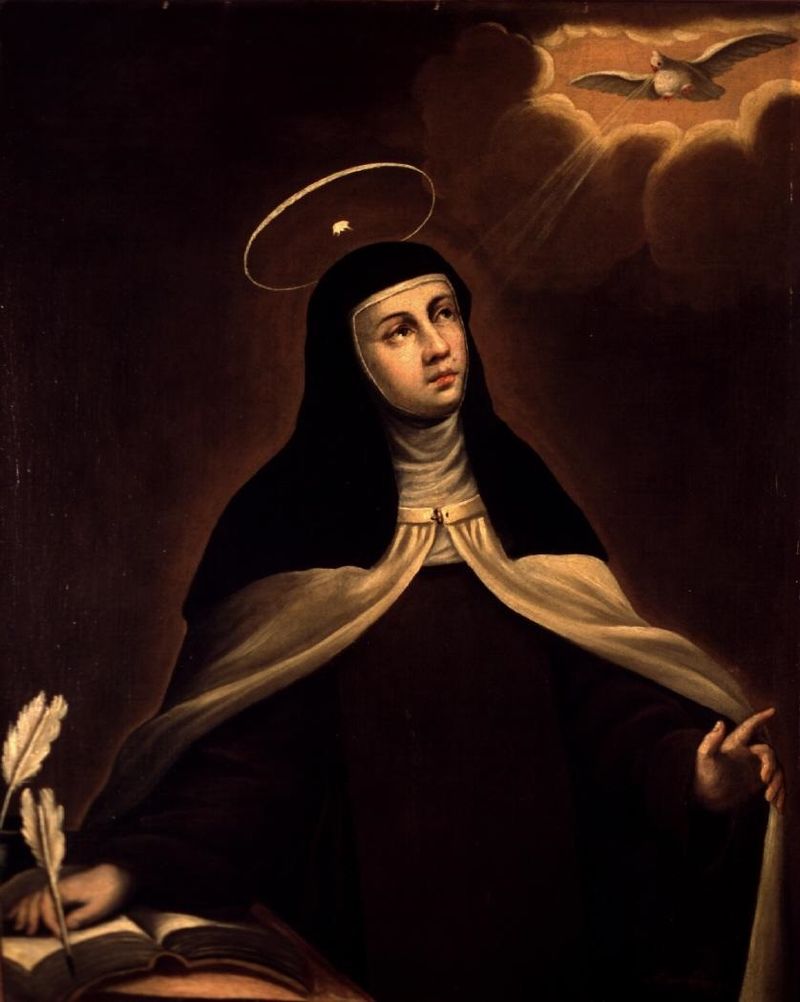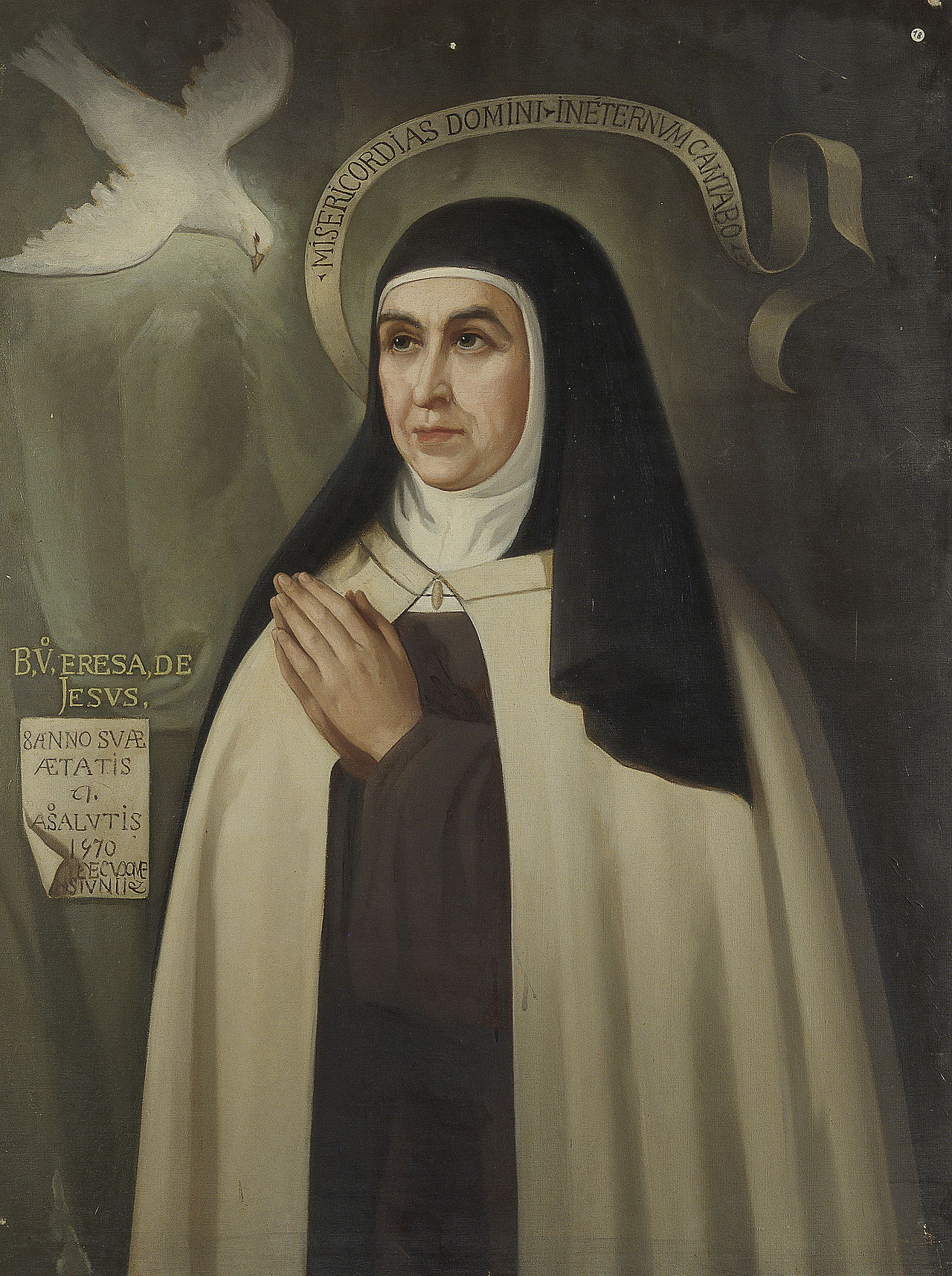
Catholic Saints
Saint Teresa of Ávila, born as Teresa de Cepeda y Ahumada in 1515 in Ávila, Spain, emerged as a towering figure in the Roman Catholic Church during the 16th century. A Carmelite nun, mystic, and prolific writer, she significantly influenced the Counter-Reformation through her profound spiritual insights and reforms. Renowned for her foundational works such as The Interior Castle and The Way of Perfection, she offered timeless guidance on prayer and the soul’s journey to God. In 1562, she established the Discalced Carmelites, a reformed branch emphasizing simplicity and contemplation, leaving a lasting imprint on religious life. Teresa’s contributions were formally recognized in 1970 when Pope Paul VI declared her a Doctor of the Church, the first woman to receive this honor, affirming her theological brilliance. She passed away in 1582, and her feast day is celebrated annually on October 15, honoring her enduring legacy in Catholic spirituality.
Her feast day is celebrated on October 15.
Doctor of the Church
Born in 1515 in Ávila, Teresa became a leading mystic and reformer of the Carmelite Order.
Saint Teresa of Ávila, originally named Teresa de Cepeda y Ahumada, came into the world on March 28, 1515, in the historic walled city of Ávila, Spain, a place renowned for its medieval charm. Her father, Alonso Sánchez de Cepeda, was a successful wool merchant who had purchased a knighthood, reflecting the family’s noble status within Spanish society. Her mother, Beatriz de Ahumada y Cuevas, a devout Catholic, nurtured Teresa and her siblings—twelve in total, though only seven survived childhood—in a household steeped in faith and piety. Beatriz’s love for romantic literature, kept secret from her disapproving husband, subtly shaped Teresa’s early imagination. As a child, Teresa showed an extraordinary spiritual curiosity; at age seven, she and her brother Rodrigo famously attempted to flee home to seek martyrdom among the Moors, only to be intercepted by an uncle. The death of her mother when Teresa was just 14 plunged her into grief, prompting her to turn to the Virgin Mary as a maternal figure, deepening her religious devotion. Her father then sent her to an Augustinian convent school in Ávila, where the nuns’ disciplined life began to awaken her vocation, though she initially resisted the call to religious life due to her enjoyment of social pleasures like fashion and friendships.
At 20, after much internal struggle and against her father’s initial objections, Teresa entered the Carmelite Monastery of the Incarnation in Ávila in 1535, adopting the name Teresa of Jesus. Her early convent years were challenging, marked by frequent illnesses, including a severe bout of malaria that left her bedridden and even temporarily paralyzed, testing her resilience. Her spiritual life during this period remained tepid, distracted by the lax atmosphere of the monastery, which allowed visitors and worldly comforts. A transformative moment came around 1554, at age 39, when an encounter with a striking image of the wounded Christ, coupled with her reading of St. Augustine’s Confessions, ignited a profound conversion. This experience unleashed a torrent of mystical visions—sometimes doubted by herself and scrutinized by confessors like St. Francis Borgia—which she later chronicled in her writings, laying the groundwork for her future as a mystic and reformer.
By the mid-16th century, Teresa grew increasingly disillusioned with the Carmelite Order’s drift from its original contemplative ideals, observing a relaxed lifestyle that included private property, frequent visitors, and diminished focus on prayer—a stark contrast to her deepening spiritual commitment following her 1554 conversion. Inspired by a vision to restore the order’s austerity, she resolved to establish a reformed branch, the Discalced Carmelites, meaning “barefoot,” symbolizing their return to poverty and simplicity. In 1562, after securing permission from the papal legate and with guidance from St. Peter of Alcantara, she founded her first reformed convent, St. Joseph’s in Ávila, enforcing strict enclosure, communal poverty, and a rigorous prayer schedule. This bold move sparked fierce opposition from both secular authorities, who feared economic impacts, and her own order, which branded her a troublemaker, yet Teresa’s unwavering resolve, bolstered by influential supporters, triumphed.
Her reform efforts expanded rapidly as she collaborated with St. John of the Cross, founding the first male Discalced monastery in Duruelo in 1568. By her death in 1582, she had established 17 convents for women and two monasteries for men, each a testament to her vision of a life centered on contemplation and detachment from worldly distractions. Teresa’s writings, including The Interior Castle, The Way of Perfection, and The Constitutions, served as both spiritual guides and practical manuals for her communities, offering profound yet accessible insights into mental prayer and the soul’s ascent to God. Written in a warm, conversational tone, these works transcended her time, becoming enduring classics that shaped Catholic mysticism and theology, influencing not only her order but also the broader Church for centuries.
Teresa of Ávila breathed her last on October 4, 1582, in Alba de Tormes, Spain, after a life of relentless spiritual pursuit and reform. Her death marked the beginning of a swift recognition of her sanctity; she was beatified in 1614 by Pope Paul V and canonized in 1622 by Pope Gregory XV, alongside luminaries like St. Ignatius of Loyola, cementing her status as a pivotal figure in the Church. In a historic milestone, Pope Paul VI proclaimed her the first female Doctor of the Church in 1970, honoring her theological depth and the universal resonance of her writings, such as The Interior Castle. Her relics, preserved in Alba de Tormes, remain a site of veneration, drawing pilgrims seeking her intercession, while her literary legacy continues to inspire Christians globally, translated into countless languages and studied by scholars and spiritual seekers alike.
As the patroness of Spain and those in need of grace, Teresa’s influence extends beyond her writings to the thriving Discalced Carmelite order, which perpetuates her emphasis on interior prayer and contemplation worldwide. Her mystical experiences, notably the transverberation of her heart, have inspired masterpieces like Bernini’s Ecstasy of St. Theresa, embedding her in cultural history. Modern popes, including Pope Francis, have lauded her as a model of holiness, ensuring her relevance endures. Teresa’s life—a rare fusion of mysticism, practical reform, and fearless leadership—left an indelible mark on the Church, making her one of its most cherished saints.
Born in Ávila.
Born into a noble Spanish family.
Joined the Monastery of the Incarnation.
Began her religious life.
Founded St. Joseph’s Convent.
Initiated the Discalced Carmelite movement.
Wrote The Interior Castle and other texts.
Shared her mystical insights.
Died in Alba de Tormes.
Passed away and later canonized in 1622.

“Let nothing disturb you, let nothing frighten you, all things are passing away; God never changes.”
Saint Teresa of Ávila Quotes
“Prayer is an act of love; words are not needed. Even if sickness distracts from thoughts, all that is needed is the will to love.”
“The closer one approaches to God, the simpler one becomes.”
“To have courage for whatever comes in life—everything lies in that.”
“The soul is like a castle made of a single diamond, in which there are many rooms, just as in heaven there are many mansions.”
“We can only learn to know ourselves and do what we can—namely, surrender our will and fulfill God’s will in us.”
“Let nothing disturb you, let nothing frighten you, all things are passing away; God never changes.”